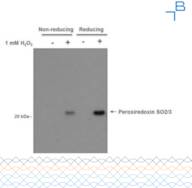Informations sur le produit
Peroxiredoxins (Prxs) are a recently identified highly abundant and reactive family of antioxidant enzymes that reduce H2O2 via cysteine residue reactivity and make up the major cellular sink for cellular peroxides. Prxs are essential for preventing neurodegenerative disorders, haemolytic anaemia and inflammation from oxidative stress through the elimination of H2O2. The cysteine residues of Prx1-4 proteins are converted to thioredoxin (Trx) via a sulfenic intermediate and a disulphide bridge. However due to the slow rate of conversion to the disulfide, the sulfenic intermediate is occasionally over-oxidized to cysteine sulfinic acid (Cys-SO2H) or cysteine sulfonic acid (Cys-SO3H), which leads to the inactivation of the peroxidase activity. Prx proteins exhibit circadian cycles in their oxidation status in the absence of transcription and the inactivated form of the enzyme displays circadian accumulation. Overoxidized Prxs are also seen in excessive oxidative stress conditions such as the balloon-injured rat carotids, human atherosclerotic lesions, Pyrazole-induced liver Injury, and aged rat liver.
0.25 mg/ml. Used for WB/ELISA. Reacts with Human and Frog.
Image: Western blot analysis of mouse fibroblasts incubated with vehicle or 1mM H2O2 for 15 minutes.
Anti-Peroxiredoxin SO2/3 antibody TEA has been used in a recently published article. Read more here.





